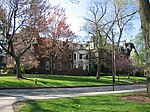Elm Street Historic District (Northampton, Massachusetts)

The Elm Street/Round Hill Historic District is a local historic district in the city of Northampton, Massachusetts. Established in 1994 along one mile of Elm Street it was expanded to include Round Hill Road in 2012.There are 139 buildings ranging in style from early 18th century colonial to Modern and International style.The first lots on what is now Elm Street (from Main Street to Round Hill) were granted between 1659 and 1661.The founding of Clarke School for the Deaf in 1867 and the founding of Smith College in 1871 marked the beginning of a significant number of institutional buildings in a wide range of architectural styles at the eastern end of the district (Smith College) and Round Hill Road (Clarke Schools). There was a boom in residential home building from the mid-19th to early 20th century and as a result many homes are Queen Anne and Colonial Revival style. In 2013 the Clarke Schools sold 12 acres with ten buildings to a developer who will create luxury condominiums and commercial space.Catholic churches punctuate each end of the district.Elm Street is part of Massachusetts Route 9 which runs East/West between Pittsfield, Massachusetts and Boston, Massachusetts.
Excerpt from the Wikipedia article Elm Street Historic District (Northampton, Massachusetts) (License: CC BY-SA 3.0, Authors, Images).Elm Street Historic District (Northampton, Massachusetts)
North Elm Street, Northampton
Geographical coordinates (GPS) Address External links Nearby Places Show on map
Geographical coordinates (GPS)
| Latitude | Longitude |
|---|---|
| N 42.320277777778 ° | E -72.641111111111 ° |
Address
Elm Street Historic District
North Elm Street
01063 Northampton
Massachusetts, United States
Open on Google Maps







